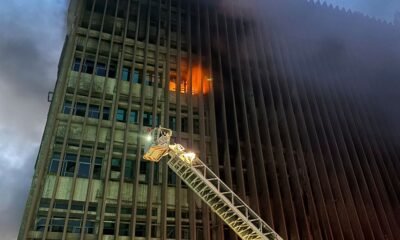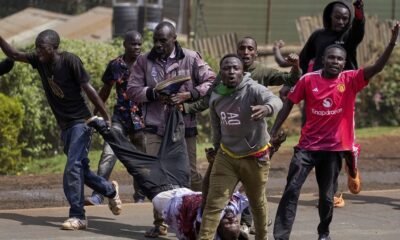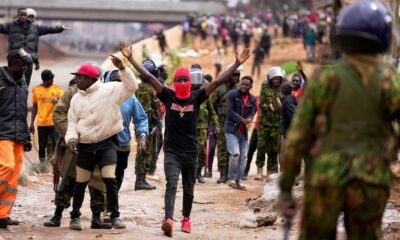Conflict Zones
‘Inch by inch’: Myanmar rebels close in on key military base in Chin State | Military News

Falam township, Chin State – In the mountains of western Myanmar, photographs of fallen fighters line a wall of a rebel headquarters – an honour roll of some 80 young men, beginning with 28-year-old Salai Cung Naw Piang, who was killed in May 2021.
The true toll on the Chin National Defence Force (CNDF) extends beyond this hall and grows as war against Myanmar’s military grinds on in Chin State – a Christian region of the country bordering India where ethnic Chin fighters have expelled the military from most of their territory.
“Even if they don’t surrender, we will go till the end, inch by inch,” CNDF Vice President Peter Thang told Al Jazeera in a recent interview.
Launched in mid-November, the Chin offensive to capture the town of Falam – codenamed “Mission Jerusalem” – has come at a heavy cost. About 50 CNDF and allied fighters were killed in the first six weeks, some buried alive after direct air strikes by jet fighters of Myanmar’s military regime on earthen bunkers, Thang said.
Thang estimated similar casualties among Myanmar’s military, and more than 100 government soldiers captured, in the continuing operation.
Formed by civilians to fight the military after the 2021 coup in Myanmar, the CNDF has encircled the regime’s last garrison in a hilltop base in Falam.
“We are facing a difficult time,” Thang admitted.
“If God is willing to hand over the enemy, we will take it,” he said of Mission Jerusalem’s ultimate objective.
Taking and holding Falam – Chin State’s former capital – would also mark the first district centre captured by the country’s new rebel forces without support from established ethnic armies, according to Thang, who ran a travel agency in Myanmar’s commercial capital Yangon before the coup.
“We have more challenges than others,” he said.
“The military has so much technology. We have limited weapons, and even some of them we can’t operate,” he added.
![Peter Thang, Chin National Defence Force (CNDF) vice president, sits in front of the CNDF flag during an interview in a village at the frontline in Falam, Chin State, Myanmar, January 2, 2025. [Valeria Mongelli/Al Jazeera]](https://www.aljazeera.com/wp-content/uploads/2025/03/AB5A6226-1742020482.jpg?w=770&resize=770%2C513)
Besieged hilltop base
With the CNDF supported by fighters from 15 newly formed armed groups, including from Myanmar’s ethnic Bamar majority, about 600 rebels have besieged Falam and the roughly 120 government soldiers who, confined to their hilltop base, depend on supplies dropped by helicopter for their survival.
Unlike established ethnic armies who are fighting to gain more territory for themselves, the rebel forces massed in Chin State said they aim to overthrow Myanmar’s military regime entirely.
While the CNDF and allies in the Chin Brotherhood (CB) coalition scored previous victories against the military with help from the powerful Arakan Army (AA) to the south in Rakhine State, seizing Falam independently would represent a new phase in Myanmar’s revolution.
But the biggest challenge in the battle remains aerial attacks by the military.
Operations against the hilltop base in Falam trigger bombardments from the military’s Russian and Chinese fighter jets, along with rocket-propelled grenades, artillery, sniper and machinegun fire from troops defending the outpost.
![A Chin National Defence Force (CNDF) fighter points to the Myanmar military's base in Falam, Chin State, Myanmar, December 31, 2024. Peter Thang, Chin National Defence Force (CNDF) vice president, sits in front of the CNDF flag during an interview in a village at the frontline in Falam, Chin State, Myanmar, January 2, 2025. [Valeria Mongelli/Al Jazeera]](https://www.aljazeera.com/wp-content/uploads/2025/03/0H1A3676-1742020649.jpg?w=770&resize=770%2C513)
CNDF commanders told how the besieged soldiers once chatted freely with locals and some had even married local Chin women. But that all changed when Myanmar’s security forces shot peaceful protesters demonstrating against the military’s ousting of Aung San Suu Kyi’s elected government in 2021.
Demonstrators fought back, and an uprising was born that has become steeped in blood and the lore of many martyrs.
Mya Thwe Thwe Khaing, a 19-year-old protester, was the first victim – shot in the head by police on February 9, 2021 in the country’s capital, Naypyidaw.
In April 2021, armed with hunting rifles, the Chin launched the first significant battle of Myanmar’s uprising in Mindat town, which has since been liberated.
Now the rebels are equipped with assault rifles and grenade launchers. They control most of the countryside and several towns, but remain outgunned, as the military entrenches itself in urban centres. Unable to launch ground offensives from their depleted ranks, the regime’s generals have turned to forced conscription and indiscriminate air strikes nationwide.
According to rights group the Assistance Association for Political Prisoners, the military has killed at least 6,353 civilians since the coup. With at least 3.5 million people displaced inside the country, according to the United Nations, observers predict even fiercer fighting this year.

‘Some died, others ran in all directions’
In Falam, CNDF defence secretary Olivia Thawng Luai said spouses live with some of the soldiers in the surrounded hilltop holdout.
“Most soldiers want to leave their base but they are under the commander’s control,” said Olivia Thawng Luai, a former national karate champion. “They aren’t allowed to leave the base or use their phones,” she said.
Another senior CNDF figure, Timmy Htut, said the commander in the besieged base still has his own phone – and the rebels call his number regularly.
“One day he will pick up,” he said. “When he’s ready.”
Attempts by the military to send reinforcements to Falam have failed. Helicopters, facing sheets of gunfire, have dropped conscripted airborne recruits on Falam’s outskirts, ordering them to fight their way into the town. None has succeeded.
![Olivia Thawng Luai, Chin National Defence Force (CNDF)'s defence secretary, is portrayed in a village at the frontline in Falam, Chin State, Myanmar, January 1, 2025. [Olivia Thawng Luai, Chin National Defence Force (CNDF)'s defence secretary, sits in front of the CNDF flag during an interview in a village at the frontline in Falam, Chin State, Myanmar, January 1, 2025 A Chin National Defence Force (CNDF) fighter stands on the ruins of a church bombed by a Myanmar military jet in Falam township, Chin State, Myanmar, December 31, 2024. [Valeria Mongelli/Al Jazeera]](https://www.aljazeera.com/wp-content/uploads/2025/03/AB5A6023-1742020999.jpg?w=770&resize=770%2C513)
A captured soldier said his unit was dropped in without a plan, and, under heavy fire and pursued by resistance fighters, they scattered in chaos.
“Some died, others ran in all directions,” the soldier told Al Jazeera.
“The headquarters said they couldn’t waste their jet sorties for just a few of us,” he said. The military, he continued, has lost “many skilful, valuable” soldiers since the coup.
“They gave their lives for nothing,” he said.
“In the end, the military leaders will offer peace talks, and there will probably be democracy.”
Among the people displaced by fighting in Falam, and who are forced to shelter under bridges and tarpaulins, a new generation prepares to fight.
Junior, 15, who assists at a Chin hospital camp, spoke from an air raid shelter within earshot of jets dropping bombs.
“I’ll do whatever I can,” Junior said. “There’s no way to study in Myanmar. I don’t want future generations to face this,” she said.

‘None of you would be alive’
But the Chin resistance is also grappling with internal division. It has split into two factions: one led by the Chin National Front (CNF), established in 1988, along with its allies, and the other, the Chin Brotherhood, comprising six post-coup resistance groups, including the CNDF.
Their dispute centres on who shapes Chin’s future – the CNF favouring a dialect-based governance structure, the CB preferring the governing of townships. This distinction between language and land determines the distribution of power, and, coupled with tribal rivalries and traditional mistrust, has led to occasional violent clashes among the Chin groups.
Myanmar analyst R Lakher described the divide as “serious”, though mediation efforts by northeast India’s Mizoram authorities show progress.
On February 26, the two rival factions announced they would merge to form the Chin National Council, with a goal of uniting different armed groups under one military leadership and administration.
While welcoming the development, Lakher stressed the process must be “very systematic” and include key political leaders from either side, not only advocacy groups.
“Chin civilians have suffered most,” he said. “Despite liberation, some cannot return home because of this internal conflict.”
Capturing Falam would be “significant”, he said, as nearby Tedim town would then present an easier target, potentially freeing up more territory for the CB and strengthening their negotiating position with the CNF coalition.
Lakher estimated more than 70 percent of Chin State has been liberated.
“We’ve seen the junta being defeated across Myanmar,” he said. “But pro-democracy forces need unity.”
He said the onus was on the National Unity Government – described as Myanmar’s shadow government – to “bring all democratic forces together”.
“With so many armed groups, there’s concern they’ll fight each other without strong leadership,” he said. “Ethnic areas are being liberated while Bamar lands remain under military control. The revolution’s pace now depends on the Bamar people.”

Along the road leading out of Falam town, two trucks loaded with captured regime soldiers drove past Chin’s bombed churches, gardens of mustard leaf, and mothers cradling babies under heavy shawls. As the trucks crossed paths with resistance fighters heading to the front, the nervous prisoners of war claimed they had been forced into military service.
“You were conscripted five months ago,” a rebel fighter remonstrated with prisoners in the truck. “What were you doing before then? he asked. He then added: “We’ve been fighting the revolution.”
Another rebel joined in the rebuke.
“Count yourselves lucky to be captured here,” he said – and not in the country’s harsh central drylands, where rebel units roam unchecked.
“None of you would be alive there,” he added.
Conflict Zones
US-backed GHF suspends Gaza aid for full day, names new evangelical leader | Israel-Palestine conflict News

Israeli military warns access roads to the Gaza Humanitarian Foundation’s (GHF) aid distribution sites are now considered ‘combat zones’.
The United States- and Israeli-backed Gaza Humanitarian Foundation (GHF) will suspend aid distribution in the war-torn territory on Wednesday, a day after Israeli forces again opened fire on Palestinian aid seekers near a GHF distribution site, killing at least 27 and injuring more than 100.
Israel’s military also said that approach roads to the aid distribution centres will be “considered combat zones” on Wednesday, and warned that people in Gaza should heed the GHF announcement to stay away.
“We confirm that travel is prohibited tomorrow on roads leading to the distribution centers … and entry to the distribution centers is strictly forbidden,” an Israeli military spokesperson said.
In a post on social media, GHF said the temporary suspension was necessary to allow for “renovation, reorganisation and efficiency improvement work”.
“Due to the ongoing updates, entry to the distribution centre areas is slowly prohibited! Please do not go to the site and follow general instructions. Operations will resume on Thursday. Please continue to follow updates,” the group said.
The temporary suspension of aid comes as more than 100 Palestinian people seeking aid have been reported killed by Israeli forces in the vicinity of GHF distribution centres since the organisation started operating in the enclave on May 27.
The killing of people desperately seeking food supplies has triggered mounting international outrage with United Nations Secretary-General Antonio Guterres demanding an independent inquiry into the deaths and for “perpetrators to be held accountable”.
“It is unacceptable that Palestinians are risking their lives for food,” Guterres said.
The Israeli military has admitted it shot at aid seekers on Tuesday, but claimed that they opened fire when “suspects” deviated from a stipulated route as a crowd of Palestinians was making its way to the GHF distribution site in Gaza.
Israel’s military said it is looking into the incident and the reports of casualties.
On Tuesday, GHF named its new executive chairman as US evangelical Christian leader Reverend Dr Johnnie Moore.
Moore, who was an evangelical adviser to the White House during the first term of United States President Donald Trump, said in a statement that GHF was “demonstrating that it is possible to move vast quantities of food to people who need it most — safely, efficiently, and effectively”.
The UN and aid agencies have refused to work with the GHF, accusing the group of lacking neutrality and of being part of Israel’s militarisation of aid in Gaza. Israel has also been accused of “weaponising” hunger in Gaza, which has been brought about by a months-long Israeli blockade on food, medicine, water and other basic essentials entering the war-torn territory.
Moore’s appointment is likely to add to concerns regarding GHF’s operations in Gaza, given his support for the controversial proposal Trump floated in February for the US to take over Gaza, remove the Palestinian population, and focus on real estate development in the territory.
After Trump proposed the idea, Moore posted video of Trump’s remarks on X and wrote: “The USA will take full responsibility for future of Gaza, giving everyone hope & a future.”
Responding on social media to UN chief Guterres’s outrage following the killing of aid seekers in Gaza on Sunday, Moore said: “Mr Secretary-General, it was a lie… spread by terrorists & you’re still spreading it.
The GHF’s founding executive director, former US marine Jake Wood, resigned from his position before the Gaza operation began, questioning the organisation’s “impartiality” and “independence”.
Critics have accused GHF, which has not revealed where its funds come from, of facilitating the Israeli military’s goal of depopulating northern Gaza as it has concentrated aid distribution in the southern part of the territory, forcing thousands of desperate people to make the perilous journey to its locations to receive assistance.
Conflict Zones
Five UN food aid workers killed in Sudan ambush as hunger crisis deepens | Sudan war News

Deadly attack on United Nations convoy in Sudan disrupts aid to hunger-stricken families in the war-torn country.
An ambush on a United Nations food aid convoy in Sudan has killed at least five people, blocking urgently needed supplies from reaching civilians facing starvation in the war-torn Darfur city of el-Fasher.
Aid agencies confirmed on Tuesday that the 15-truck convoy was transporting critical humanitarian supplies from Port Sudan to North Darfur when it was attacked overnight.
“Five members of the convoy were killed and several more people were injured. Multiple trucks were burned, and critical humanitarian supplies were damaged,” the UN Children’s Fund (UNICEF) and the World Food Programme (WFP) said in a joint statement.
The agencies did not identify the perpetrators and called for an urgent investigation, describing the incident as a violation of international humanitarian law. The route had been shared in advance with both warring parties.
The convoy was nearing al-Koma, a town under the control of the paramilitary Rapid Support Forces (RSF), when it came under fire. The area had witnessed a drone attack earlier in the week that killed civilians, according to local activists.
Fighting between the RSF and the Sudanese army has raged for over two years, displacing millions and plunging more than half of Sudan’s population into acute hunger. El-Fasher, the capital of North Darfur, remains one of the most vulnerable regions.
“Hundreds of thousands of people in el-Fasher are at high risk of malnutrition and starvation,” the UN statement warned.
Both sides blamed each other for the attack. The RSF accused the army of launching an air attack on the convoy, while the army claimed RSF fighters torched the trucks. Neither account could be independently verified.
The attack is the latest in a string of assaults on humanitarian operations.
In recent weeks, RSF shelling targeted WFP facilities in el-Fasher, and an attack on El Obeid Hospital in North Kordofan killed several medical staff. Aid delivery has become increasingly perilous as access routes are blocked or come under fire.
Conflict Zones
Two suspected Ugandan rebels killed in Kampala explosion | Conflict News

A female suicide bomber and another suspected rebel were killed in a blast in Uganda’s capital city.
Two suspected Allied Democratic Forces (ADF) rebels, including a female suicide bomber, were killed in an explosion near a prominent Catholic shrine in Uganda’s capital, Kampala, as crowds gathered to mark Martyrs’ Day.
The blast on Tuesday took place in the upscale suburb of Munyonyo, outside the Munyonyo Martyrs’ Shrine, where Ugandans were assembling to commemorate 19th-century Christians executed for their faith. No civilian injuries were reported.
“A counterterrorism unit this morning intercepted and neutralised two armed terrorists in Munyonyo,” said army spokesman Chris Magezi on X. He confirmed one of the assailants was a female suicide bomber “laden with powerful explosives”.
Footage broadcast by NBS Television, an independent outlet, showed a destroyed motorbike and debris scattered across the road. Police Chief Abas Byakagaba told NBS the explosion occurred while “two people were on a motorcycle,” adding: “The good thing, though, is that there were no people nearby who were injured.”
There has been no immediate claim of responsibility.
While Ugandan authorities are still piecing together the events, Magezi suggested the suspects were linked to the ADF, a rebel group that originated in Uganda in the 1990s but later relocated to eastern Democratic Republic of the Congo.
The ADF has pledged allegiance to ISIL (ISIS) and was behind a spate of deadly bombings in Uganda in 2021.
The group has been accused by the United Nations of widespread atrocities, including the killing of thousands of civilians in the region.
Martyrs’ Day is one of Uganda’s most significant religious holidays, drawing thousands of pilgrims annually. Security forces have increased patrols across the capital in the aftermath of the incident.
-

 Asia4 days ago
Asia4 days agoIndonesia’s Mount Lewotobi Laki Laki erupts sending ash 11 miles into sky
-

 Africa3 days ago
Africa3 days agoCairo telecom fire injures 14, disrupts internet nationwide
-

 Europe3 days ago
Europe3 days agoHe was born to a US citizen soldier on an army base in Germany. Now he’s been deported to Jamaica, a country he’d never been to
-

 Asia3 days ago
Asia3 days agoA torpedoed US Navy ship escaped the Pacific in reverse, using coconut logs. Its sunken bow has just been found
-

 Europe2 days ago
Europe2 days agoTrump promised 200 deals by now. He’s gotten 3, and 1 more is getting very close
-

 Africa4 days ago
Africa4 days agoKenya: at least 10 dead in ongoing protests, 29 injured nationwide
-

 Lifestyle3 days ago
Lifestyle3 days agoArmani couture channels black as maestro misses Paris bow for 1st time, days from 91st birthday
-

 Africa3 days ago
Africa3 days agoUN Human Rights Office says ‘deeply troubled’ by Kenya protester deaths




